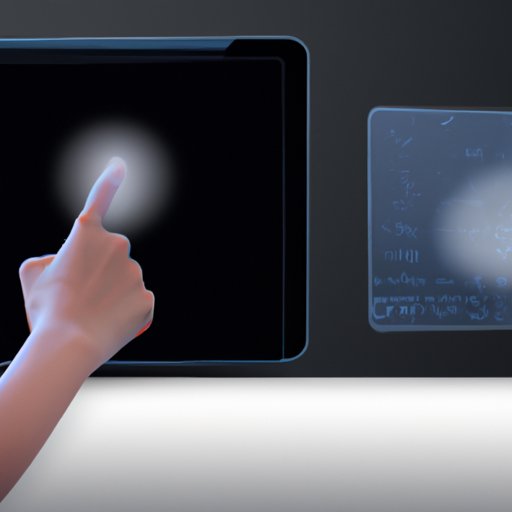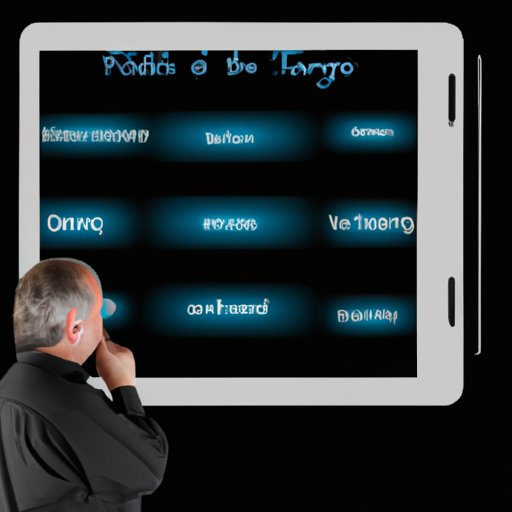Introduction
Touch screens have become an integral part of our lives. From smartphones to tablets, interactive displays, and even ATMs, touch screens are everywhere. But what makes them so special? How do these innovative devices work? This article will explore the technology behind touch screens and explain how they work.
Explaining the Technology Behind Touch Screens
At the core of touch screens is a technology known as capacitive sensing. This technology works by detecting electrical signals generated by the user’s finger when it touches the screen. The technology consists of two main components – a sensor that detects the electrical signal, and a controller that processes the signal and sends it to the computer or device.

Comprehensive Guide to Understanding Touch Screen Sensors
The sensor is the key component of any touch screen. It is responsible for detecting the user’s finger when it comes into contact with the screen. There are several types of touch screen sensors, each one designed for different applications. The most common type of touch screen sensor is the capacitive sensor. This type of sensor uses a grid of electrodes to detect the electrical signal generated by the user’s finger.
How Touch Screens Work: A Step-by-Step Process
When a user touches the screen, the capacitive sensor detects the electrical signal. The signal is then processed by the controller, which converts the signal into coordinates. These coordinates are sent to the computer or device, which can then interpret them and respond accordingly. For example, if the user touches a certain button on the screen, the computer or device will respond by performing the action associated with that button.

Introducing the World of Capacitive Touch Screens
Capacitive touch screens are the most common type of touch screen used today. They are found in many electronic devices such as smartphones, tablets, and interactive displays. Capacitive touch screens use a grid of electrodes to detect the electrical signal generated by the user’s finger. When the user touches the screen, the electrodes detect the signal and send it to the controller, which then interprets the signal and responds accordingly.
Types of Touch Screens
In addition to capacitive touch screens, there are two other types of touch screens – resistive and surface acoustic wave. Resistive touch screens use pressure-sensitive layers to detect the user’s finger. Surface acoustic wave touch screens use ultrasound waves to detect the user’s finger. Both types of touch screens are less accurate than capacitive touch screens, but they are cheaper and more durable.
Pros and Cons of Touch Screens
Touch screens offer a number of advantages over traditional input devices. They are easy to use, require minimal training, and provide an intuitive user experience. In addition, touch screens are more durable than traditional input devices, and can be used in harsh environments. On the other hand, touch screens have some drawbacks. They are prone to fingerprints and smudges, and can be difficult to use in bright light conditions.
Conclusion
Touch screens are an amazing technology that has revolutionized the way we interact with our devices. At the heart of these devices is a technology known as capacitive sensing, which uses a grid of electrodes to detect the electrical signal generated by the user’s finger when it touches the screen. In addition to capacitive touch screens, there are also resistive and surface acoustic wave touch screens. Each type has its own pros and cons, making it important to consider your needs before selecting the right touch screen for your application.
Summary of Key Points
Touch screens are an amazing technology that has revolutionized the way we interact with our devices. At the core of touch screens is a technology known as capacitive sensing, which uses a grid of electrodes to detect the electrical signal generated by the user’s finger when it touches the screen. In addition to capacitive touch screens, there are also resistive and surface acoustic wave touch screens. Each type has its own pros and cons, making it important to consider your needs before selecting the right touch screen for your application.

Final Thoughts on Touch Screens
Touch screens are an incredible technology that has changed the way we interact with our devices. From smartphones to tablets, interactive displays, and even ATMs, touch screens are everywhere. They are easy to use, require minimal training, and provide an intuitive user experience. For all these reasons, touch screens are likely to remain a staple of modern life for many years to come.
(Note: Is this article not meeting your expectations? Do you have knowledge or insights to share? Unlock new opportunities and expand your reach by joining our authors team. Click Registration to join us and share your expertise with our readers.)
